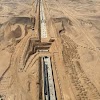Saudi financial sector sets new benchmarks in diverse areas
Saudi Arabia’s financial sector has achieved
remarkable growth in 2024, setting new benchmarks in fintech, capital markets,
and investor confidence, in line with the ambitious goals of Vision 2030.
According to the latest annual report from the
Financial Sector Development Program (FSDP), fintech companies surged to 261,
with venture capital investments in the sector surpassing SR7.6 billion ($2.03
billion). Insurance premiums grew to SR76.1 billion, while locally managed
assets in the capital market reached SR1 trillion ($267 billion). Foreign
ownership also soared, increasing by 501 percent since 2017, now totaling over
SR420 billion.
Vision 2030
in Action
Saudi Finance Minister Mohammed Al-Jadaan, who
also chairs the FSDP Committee, highlighted that the program is delivering
tangible results that contribute to Saudi Arabia’s economic diversification. “The
FSDP is not just shaping the future of the financial sector; it is reinforcing
Saudi Arabia’s regional and global position as we move towards sustainable and
inclusive growth,” he said.
Read More Reforms
offer a prosperous future in Saudi financial sector: Minister
The FSDP has implemented numerous reforms and
initiatives designed to strengthen and diversify the Kingdom’s financial
system. These efforts have stimulated innovation, created jobs, and attracted
both local and foreign investments, contributing to the broader goals of Vision
2030.
Fintech
Takes Center Stage
One of the standout success stories of 2024
has been the fintech sector. With 261 fintech firms now operating in the
Kingdom, the sector exceeded initial targets and contributed to the creation of
over 11,000 direct jobs. The Saudi Central Bank licensed D360 Bank to commence
operations, and electronic payments accounted for 79 percent of all retail
transactions, signaling a significant shift towards a cashless economy. Additionally,
the inaugural FinTech2024 conference attracted international
attention, marking the Kingdom’s growing prominence in the global fintech
landscape.
Capital
Market Growth
The capital markets have continued their
upward trajectory, with 44 new companies joining the stock exchange, pushing
the total number of publicly traded companies to 353. Locally managed assets
grew by 169 percent compared to 2017, reaching SR1 trillion, while foreign
investments surged by 501 percent to SR420 billion over the same period.
Key developments in the capital market
included the launch of the TASI 50 index, the introduction of single-stock
options, Real Estate Investment Certificates, and the listing of Saudi ETFs in
Tokyo, Shanghai, and Shenzhen. Furthermore, the Capital Market Authority (CMA)
introduced the Green Finance Framework, aimed at promoting sustainable
investments.
Debt
Capital Market and Sovereign Bonds
In the debt capital market, the CMA revealed a
comprehensive roadmap and issued its first license for an alternative trading
system. Saudi Arabia successfully completed its first international dollar bond
issuance under the Government’s Global Bond Program, attracting over $30
billion in investor demand, further solidifying its position on the global
financial stage.
Read More Muqassa
and Instimatch Global spearhead innovation in Saudi capital market
Insurance
Sector Growth
The insurance sector also posted strong
performance in 2024. Gross written premiums grew by 16.3 percent to SR76.1
billion, while net profits increased by 12.5 percent to SR3.6 billion. The
Insurance Authority’s push for Saudization in insurance sales and the launch of
a Regulatory Sandbox to support innovation helped accelerate growth in
InsurTech, with the number of licensed firms rising by 56 percent. New digital
insurance services, such as automated motor insurance and a unified tracking
platform called TELEMATICS, were introduced, making the sector more
consumer-friendly.
Empowering
Small and Medium Enterprises (SMEs)
Support for small and medium enterprises
(SMEs) remains a cornerstone of the FSDP’s strategy. In 2024, Saudi startups
attracted SR2.8 billion ($750 million) in venture capital, maintaining the
Kingdom’s lead in the MENA region. Bank credit to SMEs rose from 8.4 percent in
2023 to 9.4 percent by the end of 2024. Additionally, the SME Bank disbursed
over SR1.5 billion in financing to 1,029 businesses, and the Kafalah program
facilitated SR107.2 billion in financing guarantees, advancing the goal of SMEs
contributing 35 percent to Saudi Arabia's GDP by 2030.
Reforms
and Investor Protection
The FSDP has also introduced a series of
legislative reforms aimed at improving transparency, competitiveness, and
investor protection. Key updates include new regulations for finance and real
estate refinance companies, revisions to debt crowdfunding rules, and changes
to real estate financing. The CMA also approved omnibus accounts and relaxed
conditions for debt offerings, making the capital markets even more attractive
to investors.
Read More Vision
2030 investments fuel growth in Saudi equity and debt markets: S&P
Promoting
Financial Literacy
Financial literacy remains a priority for the
FSDP. The Financial Academy has trained more than 59,000 individuals since its
inception, while the Gulf Smart Investor Award raised awareness about personal
finance. The “Malee” program, aimed at promoting financial literacy among
children aged 8-12, was also launched.
Looking
Ahead
The FSDP is committed to building on these
successes in 2025, aligning with global standards, expanding financing options,
enhancing financial inclusion, and increasing capital market participation. The
program continues to drive innovation, regulatory efficiency, and sustainable
growth to realize the full potential of Saudi Vision 2030.
As
Saudi Arabia’s financial ecosystem reaches new heights, it is clear that the
Kingdom is well on its way to becoming a leading global financial hub, with the
FSDP paving the way for a diversified and prosperous economic future.
Source: Arab News









0 Comments